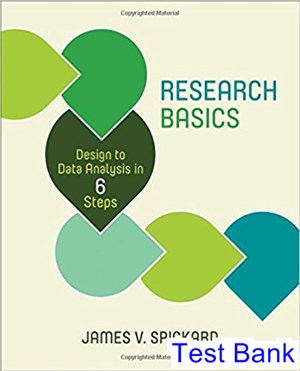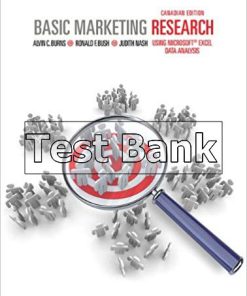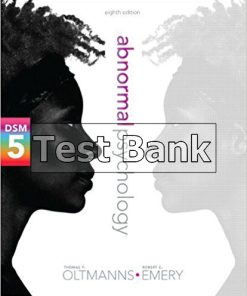Research Basics Design to Data Analysis in Six Steps 1st Edition Spickard Test Bank
$26.50$50.00 (-47%)
Research Basics Design to Data Analysis in Six Steps 1st Edition Spickard Test Bank.
You may also like
Research Basics Design to Data Analysis in Six Steps 1st Edition Spickard Test Bank

Product details:
- ISBN-10 : 9781483387215
- ISBN-13 : 978-1483387215
- Author: Jim Spickard
Research Basics: Design to Data Analysis in Six Steps offers a fresh and creative approach to the research process based on author James V. Spickard’s decades of teaching experience. Using an intuitive six-step model, readers learn how to craft a research question and then identify a logical process for answering it. Conversational writing and multi-disciplinary examples illuminate the model’s simplicity and power, effectively connecting the “hows” and “whys” behind social science research. Students using this book will learn how to turn their research questions into results.
Table contents:
For Instructors: Why This Book?
What Lies Ahead
Acknowledgments
About the Author
Introduction
Why a Six-Step Formula?
Looking Ahead
PART ONE THE SIX STEPS
Chapter 1 Step 1: Develop a Good Research Question
Start With a Research Topic
From Topic to Question
An Example: Mass Transit
Making Decisions
Search the Literature
Recraft Your Research Question
Questions Based on the Literature
Three More Possibilities
Start Your Research Proposal
The Parts of a Proposal
A Proposal in Brief: The Concept Paper
Review Questions
Notes
Chapter 2 Step 2: Choose a Logical Structure for Your Research
Three Examples
1. Comparing Outcomes
2. Systematic Description
3. Seeking Correlations
Ten Logical Structures for Research
1. True Experiments
2. Quasi-Experiments
3. Ex Post Facto Research
4. Correlational Research
5. Descriptive Research
6. Case Studies
7. Historical Research
8. Longitudinal Research
9. Meta-Analysis
10. Action Research
Matching Logical Structure to the Research Question
Review Questions
Notes
Chapter 3 Step 3: Identify the Type of Data You Need
Fourteen Types of Data
1. Acts, Behavior, or Events
2. Reports of Acts, Behavior, or Events
3. Economic Data
4. Organizational Data
5. Demographic Data
6. Self-Identity
7. Shallow Opinions and Attitudes
8. Deeply Held Opinions and Attitudes
9. Personal Feelings
10. Cultural Knowledge
11. Expert Knowledge
12. Personal and Psychological Traits
13. Experience as It Presents Itself to Consciousness
14. Hidden Social Patterns
Review Questions
Notes
Chapter 4 Step 4: Pick a Data Collection Method
Match Your Method to Your Data
Data Type 1: Acts, Behavior, or Events
Data Type 2: Reports of Acts, Behavior, or Events
Data Types 3, 4, and 5: Economic, Organizational, and Demographic Data
Data Type 6: Self-Identity
Data Types 7 and 8: Shallow and Deeply Held Opinions and Attitudes
Data Type 9: Personal Feelings
Three Examples (that include data types 10-12)
Example 1: Mass Transit and Property Values
Example 2: Mass Transit and Street Life
Example 3: Best Places to Work
Data Type 13: Experience as It Presents Itself to Consciousness
Hidden Social Patterns
Research Ethics
Unethical Research
Implementing Ethical Practices
Institutional Review Boards
Review Questions
Notes
Chapter 5 Step 5: Choose Your Data Collection Site
Demographic and Economic Data
Opinions, Identities, and Reports of Acts at a Shallow Level
Populations and Samples
Sample Size, Margin of Error, and Confidence Level
Observable Behavior
Deeply Held Opinions and Attitudes
Cultural and Expert Knowledge
Hidden Social Patterns
The Remaining Data Types
Review Questions
Notes
Chapter 6 Step 6: Pick a Data Analysis Method
Preliminary Questions
What Kind of Analysis Does Your Research Question Require?
What Form Does Your Data Take?
What Is Your Unit of Observation? What Is Your Unit of Analysis?
Working With Numeric Data: Describing
Working With Numeric Data: Comparing
Interval/Ratio Data
Ordinal and Categorical Data
Identifying Cause
What Statistical Test Should I Use?
Three Fallacies
Working With Qualitative Data
Respondent-Centered Versus Researcher-Centered Analysis
Coding
Internal Versus External Coding
Qualitative Data Analysis (QDA) Software
Warnings
Review Questions
Summarizing the Six Steps
Notes
PART TWO COLLECTING AND ANALYZING DIFFERENT TYPES OF DATA
Chapter 7 Comparing: Economic, Demographic, and Organizational Data
About Comparing
Comparing San Antonio and Portland
Comparing the 50 U.S. States
About Correlations
Three Examples
Comparing Places: Do Walkable Neighborhoods Improve Health?
Comparing Organizations: Does Treating Employees Well Increase Company Performance?
Comparing Schools: Do Charter Schools Improve Student Test Scores?
Research Ethics
Review Questions
Notes
Chapter 8 Surveying: Shallow Opinions, Identities, and Reports of Acts
Three Reminders
Two Examples
Studying School Safety
Kids’ Attitudes Toward Reading
Survey Data Analysis
Analyzing Interval/Ratio Survey Results
Analyzing Ordinal and Categorical Data
Practical Matters
Creating Your Questionnaire
Sampling (Again)
Surveying Online
Research Ethics
Review Questions
Notes
Chapter 9 Interviewing: Deep Talk to Gather Several Types of Data
Hermeneutic Interviews
An Example: “Motherloss”
How to Write an Interview Protocol
Coding Your Data
Interviews With Experts
Critical Incident Interviews
Focus Groups
Phenomenological Interviews
An Example
How Is It Done?
Other Types of Data
How Many Subjects?
Research Ethics
Review Questions
Notes
Chapter 10 Scales: Looking for Underlying Traits
Scales of Psychological Well-Being
Creating Scales
Using the Scales
Analyzing Scale Research
T-Tests and Analysis of Variance
Control Variables
Research Ethics
Review Questions
Notes
Chapter 11 Recording Behavior: Acts and Reports of Acts
Watching People
Watching Gender Speech
Collecting Self-Reports
A Variation: The Beeper Studies
Watching Animals
Watching Chimps
Ravens and Elephant-Shrews
What If They Hide?
Experiments
Experiments About Stereotype Threat
Experiments About Discrimination
Rules for Experiments
Research Ethics
Review Questions
Notes
Chapter 12 Finding Hidden Social Patterns: In Life, Texts, and Popular Culture
About Hidden Patterns
Analyzing Texts
Dreams as Texts
Other Texts
Analyzing Discourses
Critical Discourse Analysis
Two Examples
Analyzing Popular Culture: The Soaps
Research Ethics
Review Questions
Notes
Chapter 13 Ethnography: Exploring Cultural and Social Scenes
The Three Goals
Goal One: Seeing the World as the Participants See It
Goal Two: Watching What Participants Do
On Taking Field Notes
Goal Three: Understanding Hidden Patterns
What Doesn’t Matter
Steps to a Successful Ethnography
Gaining Access
Developing Rapport
Listening to Language
Being an Observed Observer
What About Objectivity?
Writing Your Results
A Word About Grounded Theory
Research Ethics
Review Questions
Notes
Chapter 14 Extended Example: Counting the Homeless
What Caused the Homeless Crisis?
Who Is Homeless?
How Can We Find and Count Street Homeless?
Peter Rossi’s Chicago Count
Martha Burt’s Weeklong Method
Counting San Bernardino
Conflicting Results
Correcting National Figures
Research Ethics
Reflections
Summary of the Six Steps
Notes
Research Guides and Handouts
Six-Steps Graphic: From Research Question to Data Analysis
What Is a Concept Paper?
How to Choose a Data Collection Method
A Template for Field Notes
How to Write an Interview Protocol
How Many Subjects? (for interview studies)
Interview Rule-of-Thumb Flowchart for Nonrandom Samples
What Statistical Tests Should I Use?
Glossary
Author Index
Subject Index
People also search:
data analysis six steps
research analysis steps
research basics pdf
research design and statistical analysis pdf
research design and data analysis
basic research study design












